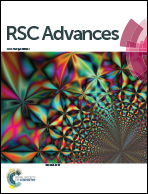Anionic CO2 activation in the anionic and di-anionic state of aza-naphthalene†
Abstract
Nitrogen-containing polycyclic aromatic hydrocarbon (PAH) is the single basic moiety in N-doped graphene, the only metal-free catalyst reported to date to successfully produce the oxygen reduction reaction. N-doped graphene is quite promising as a material to increase the efficiency of oxygen reduction. In addition, it is known that when carbon dioxide is added to aza-benzene, there will be an associative chemical reaction upon electron attachment between the anionic nitrogen atoms in the aza-benzene and the carbon atom in the carbon dioxide; however, it has previously been reported that when there are more nitrogen atoms in the small aza-benzene moiety, the associative reaction does not always occur. In this study, we carried out a theoretical simulation to determine whether more electrons increase the CO2 reductive reactivity of the aza-naphthalene as a model system of a nitrogen-containing polycyclic aromatic hydrocarbon. We found that even though an associative chemical reaction between nitrogen atoms in the N-PAH and carbon atoms in carbon dioxide did not occur in anionic complexes of aza-naphthalene and carbon dioxide, chemical reactions did occur in all the nitrogen atoms of these complexes when we added an extra excess electron. Therefore, we conclude that the efficiency of CO2 reduction will be increased in nitrogen atoms when more electrons are added to increase their anionic properties.



 Please wait while we load your content...
Please wait while we load your content...